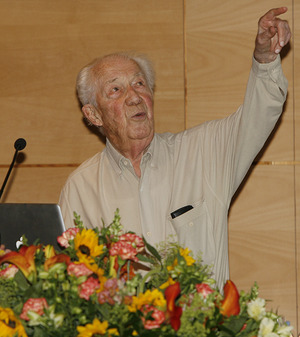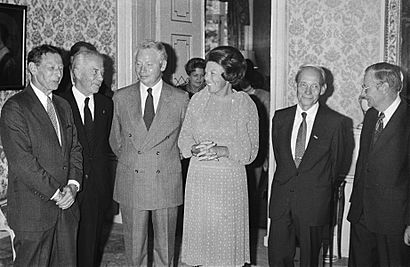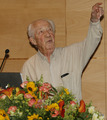Christian de Duve facts for kids
Quick facts for kids
The Viscount de Duve
|
|
|---|---|

de Duve lecturing on the origin of the eukaryotic cell in 2012
|
|
| Born |
Christian René Marie Joseph de Duve
2 October 1917 Thames Ditton, Surrey, England
|
| Died | 4 May 2013 (aged 95) Grez-Doiceau, Belgium
|
| Nationality | Belgian |
| Alma mater |
|
| Known for | Cell organelles |
| Children | 4, including Thierry |
| Awards |
|
| Scientific career | |
| Fields |
|
| Institutions |
|
Christian René Marie Joseph, Viscount de Duve (born October 2, 1917 – died May 4, 2013) was a famous Belgian scientist. He won the Nobel Prize in 1974. He was a cell biologist and biochemist.
He is known for finding two tiny parts inside cells, called organelles. These are the peroxisome and lysosome. He shared his Nobel Prize with Albert Claude and George E. Palade. They were all honored for their discoveries about how cells are built and how they work. Christian de Duve also created scientific names for important cell processes. These include autophagy, endocytosis, and exocytosis.
Contents
Early Life and Learning
Christian de Duve was born in England in 1917. His parents were Belgian refugees during World War I. In 1920, when he was three, his family moved back to Belgium. He was a very smart student and often the best in his class.
He went to a Jesuit school in Antwerp. Then, in 1934, he studied medicine at the Catholic University of Leuven. He wanted to study endocrinology, which is about hormones. He joined a lab that focused on insulin.
In 1940, during his last year of medical school, Germany invaded Belgium. He joined the Belgian army as a medical officer. He was captured but managed to escape back to Belgium. He quickly finished his medical degree in 1941.
After graduating, de Duve continued his research on insulin. He studied how insulin helps the body use sugar. He found that some insulin medicines had another hormone mixed in, called glucagon. He wrote a 400-page book about his findings in 1945. He also earned a special advanced degree in 1945. In 1946, he earned a master's degree in chemistry. For this, he worked on making penicillin pure.
To become even better at biochemistry, he trained with famous scientists. He worked with Hugo Theorell in Sweden in 1946-47. Theorell later won a Nobel Prize. In 1947, de Duve also worked with Carl and Gerti Cori in the United States. They had won a Nobel Prize in 1947.
Career and Discoveries
In 1947, Christian de Duve became a professor at the Catholic University of Leuven. He taught about the chemistry of the body. In 1960, he was invited to work at the Rockefeller Institute in New York City. This is now Rockefeller University. He made an agreement to work at both universities starting in 1962. He split his time between Leuven and New York.
In 1969, the Catholic University of Leuven split into two separate universities. De Duve chose to join the French-speaking part, Université catholique de Louvain. He retired from both universities in the late 1980s but kept doing research. He studied how different enzymes are spread out in rat liver cells. His work helped scientists understand how cell parts work. He focused on tiny parts inside cells and found new ones.
Rediscovering Glucagon
The hormone glucagon was first found in 1923. It was known to raise blood sugar. But its importance was not fully understood. When de Duve started his research, insulin medicine often had an impurity. This impurity caused a slight rise in blood sugar, which was not good. In 1944, de Duve realized that making insulin into crystals could remove this impurity. He showed that insulin from one company caused blood sugar to rise in rats, while purer insulin did not.
He then worked with Earl Wilbur Sutherland, Jr. in the United States. Sutherland was studying the same impurity, which he called the HG factor. They found that this HG factor was made in the pancreas and other parts of the digestive system. They also found it was made by special cells in the pancreas, different from those that make insulin.
De Duve realized that Sutherland's HG factor was actually glucagon. He brought the name "glucagon" back into use in 1951. Their work showed that glucagon is a main hormone. It helps break down stored sugar (called glycogen) in the liver. This releases more sugar into the blood.
De Duve also thought that insulin helps cells take in sugar. He believed there was a balance between insulin and glucagon to keep blood sugar normal. This idea was debated at first. But his work on glucagon proved he was right. In 1953, he showed that glucagon does affect how sugar is made and used.
Finding Lysosomes
Christian de Duve and his team were studying how insulin works in liver cells. They focused on an enzyme called glucose 6-phosphatase. This enzyme is important for how the body uses sugar. They tried to get this enzyme out of cells, but it was very hard. So, they used a method called cell fractionation. This method separates cell parts.
One day, they were measuring the activity of an enzyme called acid phosphatase. They found its activity was very low. But when they tested samples that had been stored for five days, the enzyme activity was much higher! This happened every time they repeated the experiment.
This made them think that something was blocking the enzyme at first. They believed there was a "sac-like structure surrounded by a membrane" that held the enzyme. This structure would break down over time, releasing the enzyme.
In 1955, de Duve named these new cell parts "lysosomes." The name means "digestive bodies" because they break things down. Later that year, another scientist, Alex B. Novikoff, used a powerful microscope to see the lysosomes. De Duve and Novikoff then confirmed that these tiny sacs contained enzymes that break down waste in the cell.
Finding Peroxisomes
De Duve made another big discovery by chance. After finding lysosomes, his team noticed another enzyme, urate oxidase, in rat liver cells. He thought it wasn't a lysosome enzyme. But it was found in similar cell parts. In 1960, he found other enzymes like catalase that were also in these same cell parts. Scientists at the time thought these were parts of mitochondria.
De Duve noticed that these enzymes acted similarly. He thought they belonged to a new type of cell part. But he didn't have enough proof yet. In 1955, his team found similar cell parts in a tiny creature called Tetrahymena pyriformis. This showed that these particles were new cell organelles, not related to mitochondria.
He shared his discovery in 1955. Then, in 1966, he officially published his findings. He named these new organelles "peroxisomes." This name came from their role in reactions that produce peroxide. In 1968, he successfully prepared large amounts of peroxisomes. This confirmed that several specific enzymes belonged only to peroxisomes.
De Duve and his team showed that peroxisomes have important jobs in the body. They help break down fats in a different way than mitochondria do. They are part of a large family of organelles found in many living things, including plants.
How Cells Began
De Duve's work helped support the endosymbiotic theory. This idea suggests that some organelles inside complex cells (called eukaryotic cells) used to be simple cells (called prokaryotic cells). These simple cells came to live inside the larger cells as partners.
De Duve thought that peroxisomes might have been the first of these partners. He believed they helped early cells survive when there was more oxygen in Earth's atmosphere. However, peroxisomes do not have their own DNA. So, there is less evidence for this idea compared to mitochondria and chloroplasts. Later in his life, de Duve studied how life began.
Books He Wrote
De Duve wrote many books, both for scientists and for the general public. Some of his well-known books include:
- A Guided Tour of the Living Cell (1984)
- Blueprint for a Cell: the Nature and Origin of Life (1991)
- Vital Dust: Life as a Cosmic Imperative (1996)
- Life Evolving: Molecules, Mind, and Meaning (2002)
- Singularities: Landmarks on the Pathways of Life (2005)
- Genetics of Original Sin: The Impact of Natural Selection on the Future of Humanity (2010)
Personal Life
Christian de Duve was raised as a Roman Catholic. Later in life, he became an agnostic. This means he believed we cannot know if God exists. He thought that life and mind are natural parts of the universe. He said he was not afraid of what happens after death because he was not a believer.
He strongly believed in biological evolution. He did not agree with ideas like creation science or intelligent design. He even signed a letter with other Nobel winners to support science education.
Family and Passing
De Duve married Janine Herman in 1943. They had two sons, Thierry and Alain, and two daughters, Anne and Françoise. Janine passed away in 2008.
Christian de Duve passed away peacefully on May 4, 2013, at his home in Belgium. He was 95 years old. He had been suffering from cancer and a heart condition. His health had also worsened after a recent fall. He chose to end his life with the help of doctors, surrounded by his children. His ashes were shared among his family and friends.
Awards and Honors

Christian de Duve won many awards for his scientific work. He received the Francqui Prize in 1960. In 1974, he won the Nobel Prize for Physiology or Medicine.
In 1989, King Baudouin of Belgium made him a Viscount. He also received the Gairdner Foundation International Award in 1967. In 1973, he won the Dr H.P. Heineken Prize for Biochemistry and Biophysics.
He was chosen as a member of many important scientific groups. These include the National Academy of Sciences in the United States and the Royal Society in London. He also received honorary degrees from eighteen universities around the world.
His Legacy
In 1974, de Duve started a research institute in Belgium. It was first called the International Institute of Cellular and Molecular Pathology (ICP). He was its president until 1991. In 1997, on his 80th birthday, it was renamed the Christian de Duve Institute of Cellular Pathology. In 2005, it became simply the de Duve Institute.
De Duve was also one of the people who started the Belgian Society of Biochemistry and Molecular Biology in 1951.
He is remembered for creating important scientific words. He named lysosome in 1955 and peroxisome in 1966. He also came up with autophagy, endocytosis, and exocytosis in 1963.
A documentary film called Portrait of a Nobel Prize: Christian de Duve was made about his life and work. It was shown on Eurochannel in 2012.
Images for kids
See also
 In Spanish: Christian de Duve para niños
In Spanish: Christian de Duve para niños



